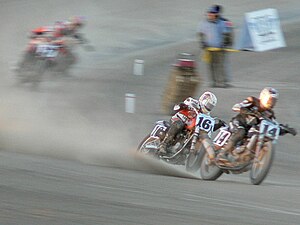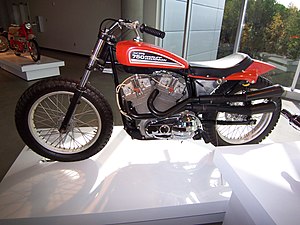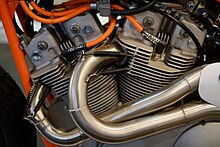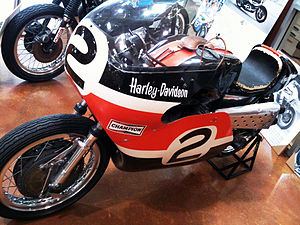
Harley-Davidson, Inc. is an American motorcycle manufacturer headquartered in Milwaukee, Wisconsin, United States. Founded in 1903, it is one of two major American motorcycle manufacturers to survive the Great Depression along with its historical rival, Indian Motorcycles. The company has survived numerous ownership arrangements, subsidiary arrangements, periods of poor economic health and product quality, and intense global competition to become one of the world's largest motorcycle manufacturers and an iconic brand widely known for its loyal following. There are owner clubs and events worldwide, as well as a company-sponsored, brand-focused museum.
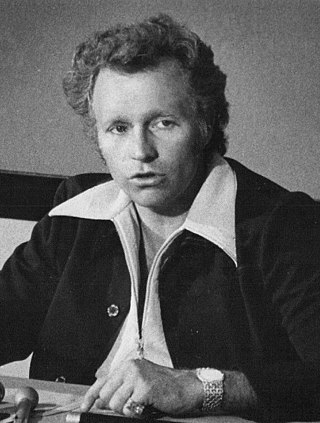
Robert Craig Knievel, known professionally as Evel Knievel, was an American stunt performer and entertainer. Throughout his career, he attempted more than 75 ramp-to-ramp motorcycle jumps. Knievel was inducted into the Motorcycle Hall of Fame in 1999. He died of pulmonary disease in Clearwater, Florida, in 2007, aged 69.

The Honda CB750 is an air-cooled, transverse, in-line-four-cylinder-engine motorcycle made by Honda over several generations for year models 1969–2003, plus 2007, with an upright, or standard, riding posture. It is often called the original Universal Japanese Motorcycle (UJM).
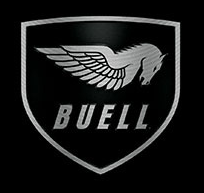
Buell Motorcycles is an American motorcycle manufacturer based in Grand Rapids, Michigan, United States. It was founded in 1983 by ex-Harley-Davidson engineer Erik Buell. Harley-Davidson acquired 49 percent of Buell in 1993, and Buell became a wholly owned subsidiary of Harley-Davidson by 2003. On November 17, 2006, Buell announced that it had produced and shipped its 100,000th motorcycle.

Robert Edward Knievel II was an American motorcyclist and stunt performer. He had also used the stage name Kaptain Robbie Knievel.
Erik F. Buell is the founder, former Chairman and Chief Technical Officer of the Buell Motorcycle Company, which eventually merged with Harley-Davidson Corp. Buell is a pioneer of modern race motorcycle technology. Buell is also the founder of Erik Buell Racing.

A motorcycle engine is an engine that powers a motorcycle. Motorcycle engines are typically two-stroke or four-stroke internal combustion engines, but other engine types, such as Wankels and electric motors, have been used.

The Honda CB450 is a standard motorcycle made by Honda from 1965 to 1974 with a 444 cc (27.1 cu in) 180° DOHC straight-twin engine. Producing 45 bhp, it was Honda's first "big" motorcycle, though it did not succeed in its goal of competing directly against the larger Triumphs, Nortons, and Harley-Davidsons in the North American market at the time. As a result, Honda tried again, leading to the development of the four cylinder Honda CB750 that marked a turning point for Honda and beginning of the "superbike" era of motorcycles.

The Harley-Davidson Sportster is a line of motorcycles produced continuously since 1957 by Harley-Davidson. Sportster models are designated in Harley-Davidson's product code by beginning with "XL". In 1952, the predecessors to the Sportster, the Model K Sport and Sport Solo motorcycles, were introduced. These models K, KK, KH, and KHK of 1952 to 1956 had a sidevalve engine, whereas the later XL Sportster models use an overhead valve engine. The first Sportster in 1957 had many of the same details of the KH including the frame, fenders, large gas tank and front suspension.

The intake/inlet over exhaust, or "IOE" engine, known in the US as F-head, is a four-stroke internal combustion engine whose valvetrain comprises OHV inlet valves within the cylinder head and exhaust side-valves within the engine block.
The Evolution engine is an air-cooled, 45-degree, V-twin engine manufactured from 1984 by Harley-Davidson for the company's motorcycles. It was made in the 1,340 cc (82 cu in) displacement for Harley-Davidson Big V-twins bikes, replacing the Shovelhead engine until 2000 when the last EVO was placed in a production factory custom FXR4. In 1999, it was replaced by the Harley-Davidson Twin Cam 88 in the Touring and Dyna model and in 2000 in the Softail models. Also available in the Sportster model beginning in 1986, it was made in the 1,100 cc (67 cu in) displacement until 1988 and is still made in the 883 cc (53.9 cu in) and 1,200 cc (73 cu in) displacements for the Harley-Davidson Sportster, replacing the ironhead Sportster engine.
The Harley-Davidson Twin Cam are motorcycle engines made by Harley-Davidson from 1998 to 2017. Although these engines differed significantly from the Evolution engine, which in turn was derived from the series of single camshaft, overhead valve motors that were first released in 1936, they share a number of characteristics with nearly all previous Harley-Davidson engines. Both engines have two cylinders in a V-twin configuration at 45°, are air-cooled, and activate valves with push-rods. The crankshafts have a single pin with a knife and fork arrangement for the connecting rods. These are sandwiched between a pair of flywheels.

James Blackwell is an American stunt performer and motorcycle jumping world record holder who is sponsored by and promoted by the Harley-Davidson motorcycle company. Before his association with Harley, Blackwell was sponsored by the now-defunct Buell Motorcycle Company.

Berliner Motor Corporation was the US distributor from the 1950s through the 1980s for several European motorcycle marques, including Ducati, J-Be, Matchless, Moto Guzzi, Norton, Sachs and Zündapp, as well as selling Metzeler tires. Berliner Motor was highly influential as the voice of the huge American market to the motorcycle companies they bought bikes from, and their suggestions, and sometimes forceful demands, guided many decisions in Europe as to which bikes to develop, produce, or discontinue.
Joe Berliner [...] a man endowed with great decision-making power in Borgo Panigale

The following outline is provided as an overview of motorcycles and motorcycling:
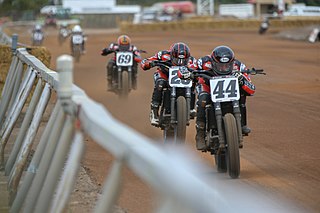
American Flat Track is an American motorcycle racing series. The racing series, founded and sanctioned by the American Motorcyclist Association (AMA) in 1954, originally encompassed five distinct forms of competitions including mile dirt track races, half-mile, short-track, TT steeplechase and road races. The championship was the premier motorcycle racing series in the United States from the 1950s up until the late 1970s.

The Harley-Davidson KR or KR750 was a 45.125 cu in (739.47 cc) displacement V-twin engine racing motorcycle made by Harley-Davidson from 1953 through 1969 for flat track racing. It was also used in road racing in the KRTT faired version. When the KR was first introduced, it dominated motorcycle racing in the United States. In 1970 it was replaced by the long-lived and US race-winning Harley-Davidson XR-750.

Doug "Danger" Senecal, born March 31, 1962, in Palmer, Massachusetts, is known as Doug Danger. He is an American motorcycle jumping world record holder and stunt performer and Stage 4 cancer survivor who lives in Oak Hill, Florida.

Flathead motorcycles are a type of bike that was a standard for pre-war motorcycles, in particular US V-twins such as Harley-Davidson and Indian, some British singles, BMW flat twins and Russian copies thereof.

The Evel Knievel Museum is a non-profit museum located in Topeka, Kansas, United States. The museum houses the largest collection of authentic Evel Knievel memorabilia in the world, including interactive experiences. It is 13,000 square feet and two stories. The museum is located adjacent to Topeka’s Historic Harley-Davidson and opened in June 2017.
